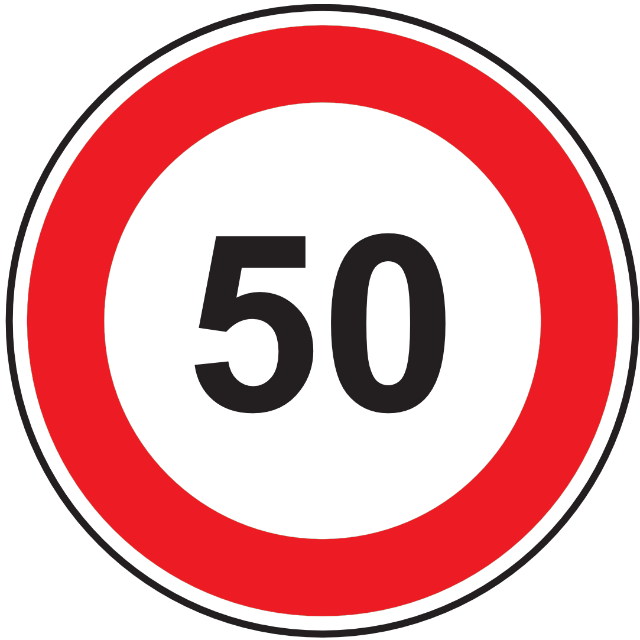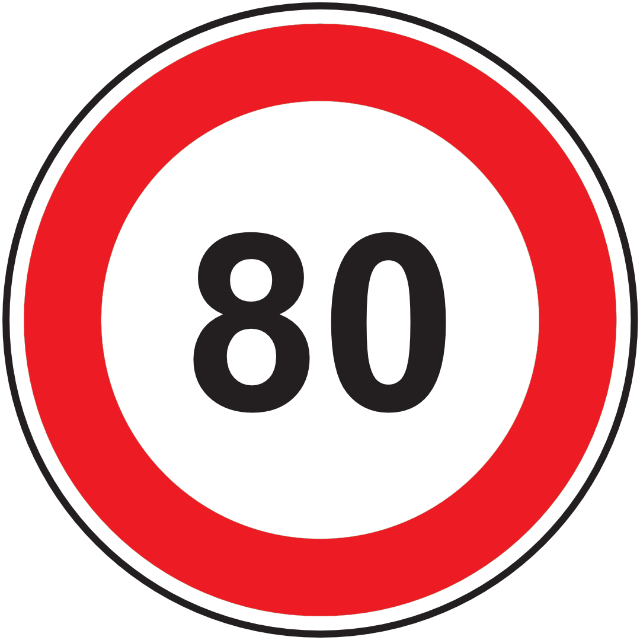Koje vas pravilo zanima?
- Sigurnosni pojasevi
- Semafori
- Ograničenja brzine
- Dopuštena količina alkohola u krvi
- Utjecaj droga
- Zabranjena traka
- Zaštitna kaciga
- Mobilni telefon
- Druga posebna pravila
Korištenje sigurnosnih pojaseva i sustava za sigurnosno vezivanje djece je OBVEZNO (Direktiva 91/671/EEZ kako je izmijenjena). The use of seat belts is not compulsory for:
The only exemptions to restraining a child in an appropriate child restraint are:
|
The sequence of traffic lights in Ireland is green, amber, red and green again. Red light: “stop” - do not go beyond the stop line at the light or, if there is no stop line, beyond the light. Green light: go on if the way is clear - take special care and give way to pedestrians who are crossing, if you turn left or right. Green arrow (also known as the filter light): you may move on in the direction of the arrow, assuming it is safe and the way is clear, even if a red light is also showing. Always look out for emergency vehicles that may be responding to an incident using blue lights and sirens. Amber light: do not go beyond the stop line or, if there is no stop line, beyond the light, unless you are so close to the line or the light that stopping would be dangerous. Flashing amber light: you may proceed only if it is safe to do so and, if appropriate, yield to other traffic. Flashing amber arrow: you may proceed in the direction of the arrow but only if it is safe to do so, and you must yield if other traffic is approaching. Failure to obey traffic lights could result in 2 penalty points and a fine of up to €120, or 5 penalty points and a fine on conviction. |
Motocikli
Vozila lakša od 3,5 t
Uobičajena ograničenja brzine (osim ako je drukčije naznačeno na prometnim znakovima) [km/h]
 | Ceste u naselju |
  | Ceste izvan naselja |
 | Autoceste/brze ceste |
Putnički automobili i kombi vozila s prikolicama
Vozila lakša od 3,5 t
Uobičajena ograničenja brzine (osim ako je drukčije naznačeno na prometnim znakovima) [km/h]
 | Ceste u naselju |
 | Ceste izvan naselja |
 | Autoceste/brze ceste |
Putnički automobili i kombi vozila
Vozila lakša od 3,5 t
Uobičajena ograničenja brzine (osim ako je drukčije naznačeno na prometnim znakovima) [km/h]
 | Ceste u naselju |
  | Ceste izvan naselja |
 | Autoceste/brze ceste |
Teška teretna vozila
iznad 3,5 t
Uobičajena ograničenja brzine (osim ako je drukčije naznačeno na prometnim znakovima) [km/h]
 | Ceste u naselju |
 | Ceste izvan naselja |
 | Autoceste/brze ceste |
Autobusi
Uobičajena ograničenja brzine (osim ako je drukčije naznačeno na prometnim znakovima) [km/h]
 | Ceste u naselju |
 | Ceste izvan naselja |
 | Autoceste/brze ceste |
| 0.5g/l Standard drivers Maximum penalties on conviction for drink or drug driving is €5 000 and/or 6 months imprisonment. | |
| 0.2g/l Novice drivers Maximum penalties on conviction for drink or drug driving is €5 000 and/or 6 months imprisonment. | |
| 0.5g/l Professional drivers Maximum penalties on conviction for drink or drug driving is €5 000 and/or 6 months imprisonment. |
Forbidden drugsTHC (cannabis) Methylamphetamine MDMA (ecstasy) The current Road Traffic Act (RTA) does not mention any specific drugs and relies on the evidence of impairment of the driver by the police (Garda) and the Medical Bureau of Road Safety Certificate of analysis for the presence of a drug or drugs. The term used in RTA is “intoxicant” and defined as alcohol and drugs and any combination of drugs or of drugs and alcohol. The RTA does not distinguish between illicit drugs and licit drugs which can be prescribed medications or over the counter medications. The consideration of driving capacity or safety is the core element rather than the legal status of the drug. Currently the Bureau analyses for the presence of the following drugs or class of drugs:
|
All traffic drives on the left in Ireland.
Motorways
Roundabouts By law, drivers must enter a roundabout by turning to the left. Drivers must treat the roundabout as a junction and give right-of-way to traffic already on it (coming from the right). If the driver is unfamiliar with driving on the left hand side of the road, roundabouts may pose a particular risk (the driver should take extra care). |
| BicikliRecommended but not mandatory | |
| MopediIt is compulsory for riders and pillion passengers to wear a safety helmet which must be properly secured. It is advisable to use dipped headlights at all times when driving. High-visibility clothing should be worn to increase visibility and to help other road users to clearly see riders and any pillion passengers. | |
| Motocikli s bočnom prikolicom ili bez njeIt is compulsory for riders and pillion passengers to wear a safety helmet which must be properly secured. It is advisable to use dipped headlights at all times when driving. High-visibility clothing should be worn to increase visibility and to help other road users to clearly see riders and any pillion passengers. | |
| Laki i teški tricikliThese vehicles are classified as category B vehicles and the Road Safety Authority strongly recommends the use of safety helmets and other protective equipment by drivers. | |
| Laki i teški četverocikliThese vehicles are classified as category B vehicles and the Road Safety Authority strongly recommends the use of safety helmets and other protective equipment by drivers. |
 | Vozači ne smiju koristiti mobilne telefone bez dodatne opreme za razgovor bez upotrebe rukuThe risk of having a crash is four times higher when the driver uses a mobile phone, and the driver could be fined up to €2 000. |
 | Vozači smiju koristiti mobilne telefone s dodatnom opremom za razgovor bez upotrebe rukuNot recommended |
| Mandatory day time running lightAll new cars must have daytime running lights (mandatory since 2011). | |
| Sigurnosna oprema za biciklisteSafety equipment for cyclists, e.g. helmets, reflective vests are not mandatory. However, their use is actively encouraged. Bicycles must have a bell, a white light to the front and a red light to the rear. |
Izjava o odricanju od odgovornosti
Informacije o sigurnosnim i prometnim pravilima na cestama pružaju nacionalna tijela u skladu s člankom 8. stavkom 1. Direktive (EU) 2015/413. Europska komisija ne preuzima odgovornost za njih ni za njihovu točnost. Najtočnije i najnovije informacije navedene su na nacionalnim internetskim stranicama, na kojima su i informacije o drugim nacionalnim propisima, među ostalim o naknadama s vremenskim ograničenjem (vinjetama), ekološkim vinjetama i cestarinama.
